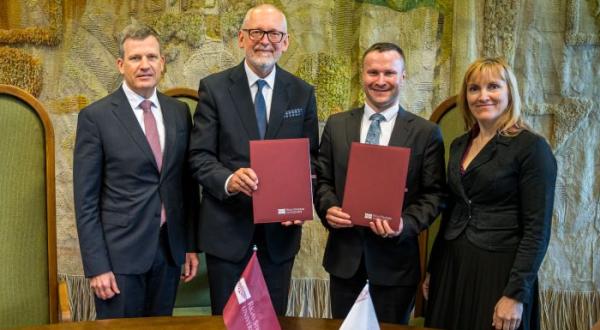Creating University of the Future
It seems that Latvia has managed to achieve success in several fields as a result of an external pressure — for example, requirements of the EU regulations and directives that had to be applied in order to ensure a well-arranged sector-policy at the moment of accessing the EU, or external threats to the national security making us to fulfil the promise regarding provision of adequate financing for the defence. Although it might seem simple, it has not always been so easy to notice the “strong arm”. The changes brought by the modern technologies are much more subtle. They have changed not only our daily lives, but also the borders of the education system.
Nowadays fields of higher education and research face increasing globalisation, competitiveness, requirements for specialisation of universities, and commercialisation of innovations. The growing cost of education in the West combined with the changes in the labour market and economic environment of the developing countries increase this pressure even more. In this regard, the World Economic Forum Global Agenda Council on the Future of Universities has defined three main challenges for the global higher education: 1) new technologies and online education affecting all study and training models; 2) innovative research and knowledge facilitated by the emergence of technologies, capital foundations, industries, and other market players that are additional factors to the unilateral impact of the universities; 3) challenges faced by the traditional values of universities. What conclusions can be drawn from that?
We often speak about one future for all universities, although actually we are speaking about variety of futures and identities for different universities. Estimates show that there will be different specialised universities — training, professional, and research universities. This variety of universities is even more supported by the rapidly increasing use of modern technologies in our daily lives. The internet and mobile devices make the higher education leave the walls of the universities and cross not only the traditional, but also the national borders. According to the data of Tele2, there were 70,000 people using tablet computers in Latvia in March 2013, this number was already more than 100,000 in October. Taking into account the fast changes, the stigma of conservatism may only disturb the development of the academic environment. And the choice whether or not the universities in Latvia will play only a local role in this global game is up to the education institutions themselves.
Cooperation of universities with profit-directed organisations, industries, and municipalities is expanding more and more in the world. In the result, universities are provided with a direct link with the market, including the possibility not only to develop study programmes according to the needs of market players, but also to popularise their specific study programmes. Market players, on their part, receive properly trained specialists, as well as the possibility to participate in facilitating the investment environment. In any case, students are the ones gaining the largest benefit as they receive the knowledge, competence, and skills demanded in the labour market.
The largest challenges will be faced by the universities with the dominant traditional training model, where one lecturer reads a monotonous lecture to a large audience. Unfortunately, already after 15 minutes the modern young people may have difficulties to stay concentrated and they may focus on their computers or smartphones instead. Today lecturers have to be ready to introduce new teaching methods both by dividing the lecture in several cycles that would include involvement of students and interactive participation, and by using e-study environment, including tablet computers, videos available on the Youtube, or applications. In case of specific study subjects, the practical training should be organised by using modern computerised moulages and 3D simulators. For example, navigating officers at the Latvian Maritime Academy first train by using computers, whereas dentistry students at Rīga Stradiņš University learn how to drill a tooth by using 3D simulators first, and only then they start treating patients.
New pedagogic solutions and introduction of new technologies in the study process would help to solve issues related with the unemployment of young people and labour market requirements. The unemployment of young people is one of the most painful issues in Europe. Latvia has one of the higher levels of youth unemployment in the EU — 28.6 % (23 % on average in the EU). At the same time, quite often young people having graduated from a university are not sufficiently ready for the labour market. Now it is the last chance to step back from the common Latvian practice to divide the study programmes into academic and professional ones. I wonder, what a graduate with academic bachelor’s degree in public relations can do if the study process does not require for any professional skills to be put in practice.
Today the universities have to shift their emphases, they have to find a speciality and approach the needs of the real world. The critics will say that modern technologies are a kind of fashion statement. In fact, modern technologies are an integral part of the education process already now. Apple, iTunes U offer more than 500,000 free lectures online already today. There were more than 7 million applications for several hundred of available study courses offered by Coursera, provider of free online courses. Not only the number and variety of the offered courses is growing, but also the number of new online education platforms. We have started to realise how the modern technologies affect not only the quality, but also the price and availability of the higher education. Time and responsible policy-related decisions will show if the higher education system in Latvia is ready for challenges.
The higher education policy decision regarding specialisation of universities and cooperation with the particular industries will create a basis for efficient division of labour, which allow for new study products and services and increase the potential of commercialising the research results. Decisions related with the distribution of EU funding for education, research, and science in the 2014–2020 planning period are going to be of the utmost importance for the further development of national economy. Only by allocating the financing to competitive universities and institutes or universities and institutes that develop sustainable human resource, research and innovation projects in cooperation with the market players and are capable of attracting co-financing can we hope for better results. An export-oriented and modern technology-based higher education system with specialised universities will be a stable basis for competitive growth of Latvian economy.
Writer
 rsu [pts] lv
rsu [pts] lvRelated news
 Four-way cooperation agreement signed to elevate health and sports science researchKonsolidācija, For Students, Development, For RSU Employees
Four-way cooperation agreement signed to elevate health and sports science researchKonsolidācija, For Students, Development, For RSU Employees


